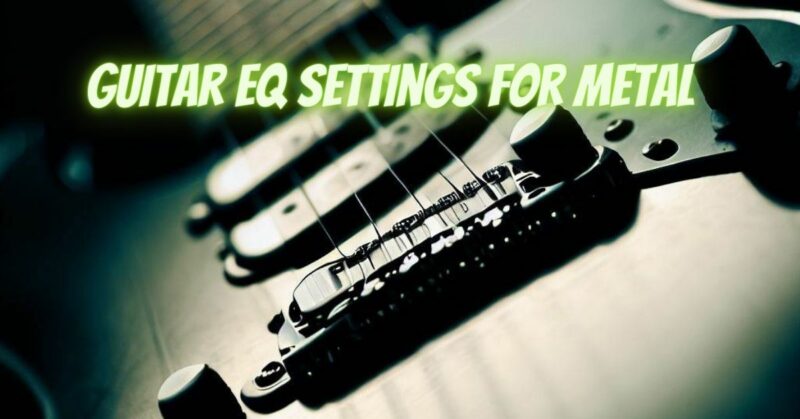Metal music demands a powerful and aggressive guitar tone that cuts through the mix with clarity and intensity. EQing your guitar for metal requires careful attention to specific frequency ranges to achieve the desired heaviness and definition. In this article, we will provide you with recommended EQ settings to help you achieve a crushing metal tone that will make heads bang and riffs soar.
- Shape the Low-End with the Bass: Boosting the bass frequencies adds weight and thickness to your tone, giving it the desired heaviness. Start by setting the bass control on your amplifier or pedalboard to around 8-10 (out of 10) or slightly higher, depending on your equipment. Experiment and adjust to find the sweet spot where the low-end is powerful without becoming muddy.
- Define the Aggressive Midrange: The midrange is crucial for cutting through the mix and delivering the aggressive character of metal. Boost the midrange frequencies to enhance clarity and attack. Begin by setting the midrange control on your amplifier or pedalboard between 7-9, or slightly higher if needed. Be cautious not to overdo it, as excessive midrange can result in an overly honky or nasal tone. Tweak the control to find the perfect balance.
- Add Clarity with the Treble: The treble frequencies provide the necessary bite and definition to make your guitar tone stand out in the mix. Start by setting the treble control on your amplifier or pedalboard between 7-9, or higher if required. Adjust the control to achieve the desired level of brightness and articulation without becoming harsh or shrill.
- Dial in Presence for Depth and Attack: If your amplifier or pedalboard has a presence control, use it to add depth and attack to your metal tone. Increasing the presence control by a few notches can enhance the higher harmonics and bring out the aggression in your sound. Experiment with small adjustments to find the right balance that suits your playing style and the specific characteristics of your equipment.
- Utilize High-Gain Distortion: Metal tones often require high-gain distortion to achieve the desired heaviness and sustain. Use your amplifier’s gain control or a dedicated distortion pedal to dial in the right amount of saturation and distortion. Adjust the gain to suit your playing style, genre, and the specific requirements of the song.
- Consider Using a Noise Gate: Metal playing typically involves heavy palm muting and fast-paced riffing, which can result in unwanted noise and feedback. Incorporating a noise gate pedal into your setup can help eliminate noise during silent passages and tighten up your guitar tone, enhancing clarity and precision.
- Fine-Tune to Your Taste: These EQ settings serve as a starting point, but remember that each guitarist’s preferences and equipment may vary. Experiment with small adjustments to tailor the settings to your specific guitar, amplifier, and playing style. Trust your ears and make changes according to the desired tonal characteristics you want to achieve.
Conclusion:
Achieving a crushing metal tone requires careful EQing to carve out the ideal balance of bass, midrange, and treble frequencies. Boost the bass for weight, define the midrange for aggression, and add clarity with the treble. Utilize the presence control to enhance depth and attack. Combine these EQ settings with high-gain distortion and consider incorporating a noise gate for optimal results. Experiment, trust your ears, and adapt the settings to suit your playing style, equipment, and the specific requirements of the music you play. With the right EQ settings, you can unleash a massive metal tone that will leave listeners in awe and your riffs shredding through the air.

